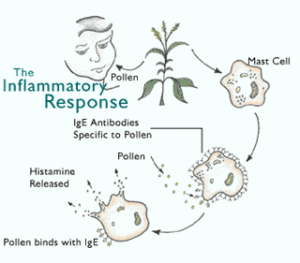Allergens
Do Allergies Play a Role in Your Asthma?
To determine whether allergies are a trigger for your asthma, ask yourself the following questions. One or more “yes” answers indicates that allergies may play a role in your asthma.
Is your asthma worse in certain months?
Do asthma symptoms occur when you visit friends who have pets?
If you have a pet, do symptoms improve when you spend time away from home?
Does your asthma get worse when dust is raised as you clean?
Do you develop asthma symptoms when you walk in the country?
Are your asthma symptoms brought on by your work environment or by performing certain tasks at your job?
What Happens in Asthma
When a foreign substance which your immune system considers dangerous, is touched, inhaled or eaten, it is called an allergen. Your immune system is immediately activated. Antibodies called IgE are produced – these are specific proteins which work against the particular allergen to destroy it. They are released into the blood by white blood cells, and acivate mast cells.

On this Page:
House Dust Mite
Animal Dander
Pollens
Moulds
Mast cells are found throughout most of your airways. They contain chemicals such as histamines and Leukotrines which cause asthma symptoms.
IgE is mostly concentrated in the airways, skin and digestive system so may also cause the symptoms of hay fever, rashes or stomach upsets associated with asthma.
For some asthmatics another antibody also becomes involved – IgG. This allergic response doesn’t usually start until three to four hours after exposure to the allergen but continues to last for twenty four to thirty six hours, thus considerably prolonging the asthma attack. An allergen can be almost anything and includes such varied things as bananas, cat dander, pollen, moulds, roses, coffee, horse hair, saw dust, soap powder, orange juice, feathers, alcohol, milk, grasses, chicken, chocolate and dust mites particles.
House dust mites
House dust mites are a commmon allergen. They are not visible to the naked eye, as they are about a third of a millimetre long. Dust mites live in furniture, carpets, and mattresses. They are found in their millions, in every home, no matter how clean. They eat the flakes of skin we constantly shed, and thrive in moist and warm environments. They trigger IgE reactions to susceptible asthmatics. Signs of dust mite allergy include asthma when you enter a dusty room or are dusting or vacuuming.
Some anti-dust mite strategies are extremely radical, such as ripping up carpets or throwing out furniture. So make sure that your asthma will actually improve before embarking on such strategies. Here are a few simple ways to reduce their presence:
Direct sunlight kills dust mites, so put bedding out in the sun on the clothesline every few weeks.
Washing sheets in hot water kills dust mites
Allow the room to be regularly aired
Where possible keep dusty objects out of the bedroom such as dried flowers or macrame
Regular vacuuming while the asthmatic is away from the area and cleaning with a damp cloth to pick up dust are encouraged
Covers for both mattresses and pillows that act as a barrier to dust mites can be purchased
Animal Dander
The fur, or sometimes the skin, scales or saliva, of animals or birds may act as an allergen. While the pet is around the symptoms will persist. Whether the cat or dog is short-haired or long-haired makes no difference. Rabbits, hamsters, guineapigs, birds and mice can trigger IgE reactions to susceptible asthmatics.
It is easy in theory to say “Get rid of your pets”, but in practise we have become very attached to pets. The sudden elimination of a beloved pet could do more harm than good, so ensure that you are actually allergic to the pet, try asking someone to look after your pet for a month or so and see if symptoms go away.
If the pet is an asthma trigger, you can either give it away, or keep it and try to reduce allergies by:
having another person brush it regularly, outside the house by a non-asthmatic
bathing it once a week with a good shampoo – can remove a lot of the dander that causes irritation
not letting animals into the bedroom or on furniture
vacuum and dust regularly
Pollens
Some asthma sufferers are susceptible to specific pollen allergens at particular times of the year. They can come from grasses, trees or flowers and differ in various parts of the world. Pollens are only around at particular times of the year. Asthma which is only triggered by a specific pollen is called seasonal asthma. They are almost impossible to avoid.
It is wise to:
garden when the pollen count is low – on cooler, less sunny days, and in the morning rather than afternoon
plants that are insect-pollinated are less likely to become airborne so are preferable to wind pollinated plants. Try to use them in the garden
Moulds and Fungal Spores
The spores of moulds and fungi are a potential allergen hazard. They are usually around in warmer months, but can occur indoors in winter months. They exist in damp, dark, humid or poorly ventilated rooms and are also carried around in the air.
Tips:
Keep the house well-ventilated
Remove mould or mildew from walls, shower curtains and so on with a fungicide. If your asthma is also triggered by cleaning product fumes then ask someone else to do this for you
